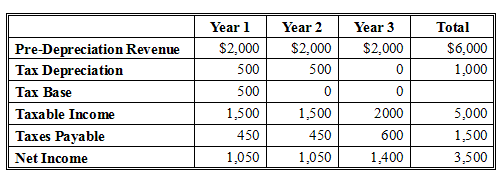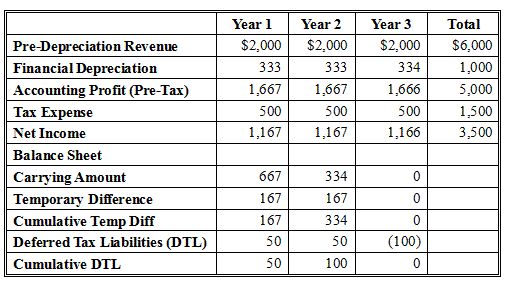Do you want BuboFlash to help you learning these things? Or do you want to add or correct something? Click here to log in or create user.
Subject 2. Deferred Tax Assets and Liabilities
#cfa #cfa-level-1 #financial-reporting-and-analysis #has-images #income-taxes #inventories-long-lived-assets-income-taxes-and-non-current-liabilities
Tax reporting and financial reporting are based on two different sets of assumptions. This is particularly true in the U.S. because financial reporting does not have to conform to tax reporting, as it does in Japan, Germany, and Switzerland. Numerous items create differences between accounting profit and taxable income. As a result, the taxes payable for the period are often different from the tax expenses recognized in the financial statements.

Taxes payable = Taxable income x Tax rate
In the U.S.:
- Tax reporting is based on the Internal Revenue Code (the tax code).
- The modified cash basis of accounting is used in tax reporting to determine the periodic liability from currently taxable events.
- Revenue and expense recognition methods used in tax reporting often differ from those used in financial reporting.
- Financial reporting is based on GAAP.
- Accrual accounting is used in financial reporting to provide maximum information to allow evaluation of a firm's financial performance and cash flows.
- Management is allowed to select revenue and expense recognition methods. A firm has a strong incentive to use methods that allow it to minimize taxable income.
Because of the differences between tax accounting and financial accounting, the financial statements may include tax liabilities or assets - allowances that have been made in the financial statements for taxes that have not yet been or have already been paid.
Deferred tax liabilities generally arise when tax relief is provided in advance of an accounting expense, or when income is accrued but not taxed until received. Deferred tax liabilities on an individual transaction are expected to be reversed when these liabilities are settled, causing future cash outflows.
A typical example is depreciation: a company uses the Accelerated Cost Recovery System for tax reporting but uses straight-line depreciation for financial reporting.
- Recall that taxes payable is calculated based on taxable income, and tax expense is calculated based on accounting profit.
- Lower depreciation expense in financial reporting results in accounting profit that is higher than taxable income, and tax expense that is higher than taxes payable.
- Deferred tax liabilities are thus created.
Deferred tax assets generally arise when tax relief is provided after an expense is deducted for accounting purposes. Deferred tax assets on an individual transaction are expected to be reversed when these assets are recovered, causing future cash inflows. Different treatments of warranty expenses in tax reporting and financial reporting are a common cause of deferred tax assets:
- For tax reporting, warranty expenses cannot be recognized until they have been incurred. For financial reporting, warranty expenses are recognized each year using accrual accounting, regardless of whether they are incurred or not.
- Lower warranty expense in tax reporting results in taxable income that is higher than accounting profit, and tax payable that is higher than tax expense.
- Deferred tax assets are thus created.
In the U.S., deferred tax assets/liabilities are classified on the balance sheet as current or non-current based on the classification of the underlying asset or liability. However, deferred tax assets/liabilities are always classified as non-current under IFRS.
A deferred tax item cannot be created if it is doubtful that the company will realize economic benefits in the future.
Example
A company purchases an asset for $1,000 at the beginning of Year 1. It depreciates the asset at 33% per annum (straight-line) for financial reporting. The tax depreciation is 50% per annum (straight-line). The pretax income and taxable income are $2,000 before depreciation for Year 1 to 3. Assume a tax rate of 30%.
The company will report the following for tax reporting:

Taxes payable is based on taxable income, not accounting profit.
Taxes payable = Taxable income x Tax rate
The company will report the following for financial reporting:

The deferred taxation can be computed in two ways:
- (Taxable income - accounting profit) x tax rate
- (Tax base - carrying amount) x tax rate
Take Year 1 as an example:
- (Taxable income - accounting profit) x tax rate = (1,500 - 1667) x 30% = -50
- (Tax base - carrying amount) x tax rate = (500 - 667) x 30% = -50
The textbook uses the second approach to calculate deferred tax assets/liabilities. At the end of each year, these are calculated by comparing the tax base and carrying amounts of the balance sheet items.
Note that tax expense can be broken down into taxes payable and deferred taxation.
- Year 1: taxes payable (450) + deferred tax liabilities (50) = Tax expense (500)
- Year 2: taxes payable (450) + deferred tax liabilities (50) = Tax expense (500)
- Year 3: taxes payable (600) + deferred tax liabilities (-100) = Tax expense (500)
In Year 1 and 2 the deferred tax is a liability in the balance sheet and an additional expense in the income statement. This occurs because the tax depreciation (500) is greater than the accounting depreciation charge (333). If the situation had been the other way around, a deferred tax asset would have resulted. This is the case when the pretax accounting profit is less than the taxable income.
In Year 3 the deferred tax is a reversal of the deferred tax liability on the balance sheet and a saving in the income statement. This occurs because the tax depreciation (0) is less than the depreciation charge for financial reporting (334).
As can be seen above, at the end of the three years there is no deferred tax on the balance sheet. This is why it is referred to as a temporary difference. The total tax (1,500) and total net income (3,500) are the same for tax and financial reporting. It is just the timing of their recognition that is different. At the end of the day, the tax collector and the accountant arrive at the same result.
Here are some important "tricks" you will need to know well for the exams.
A common question on the exam asks you to compute taxes payable or the tax expense. You may be given the pretax income, but need the taxable income figure to compute taxes payable. To adjust pretax income to taxable income and vice versa when assets have different depreciable lives for tax and accounting, remember the following:
- Pretax income + Accounting depreciation - Tax depreciation = Taxable Income, or
- Taxable Income + Tax depreciation - Accounting depreciation = Pretax Income, or
- Taxable Income + Temporary differences creating deferred tax liabilities - Temporary differences creating deferred tax assets = Pretax Income
Once you have determined the pretax income or taxable income, you can determine the taxes payable and tax expense as follows:
- Pretax income x tax rate = tax expense in the income statement
- Taxable income x tax rate = taxes payable
- Taxes payable + deferred tax effect on income statement = tax expense in the income statement
If you want to change selection, open original toplevel document below and click on "Move attachment"
Summary
| status | not read | reprioritisations | ||
|---|---|---|---|---|
| last reprioritisation on | suggested re-reading day | |||
| started reading on | finished reading on |
Details
Discussion
Do you want to join discussion? Click here to log in or create user.